Impact of Stigma on Mental Health and Service Improvement Strategies
VerifiedAdded on 2020/10/22
|11
|3603
|463
Report
AI Summary
This report delves into the critical issue of stigma within the health and social care sector, examining its profound impact on mental health. It begins by defining stigma and exploring key theories and concepts, including the work of Erving Goffman and different types of stigma such as discredited, discreditable, enacted, internalized, and anticipated stigma. The analysis then focuses on the direct relationship between stigma and mental health, highlighting how stigma contributes to health inequalities and psychological distress. The report uses eating disorders and anxiety disorders as examples to illustrate the effects of stigma. Furthermore, it provides an overview of the current issues, statistics, and real-world examples to emphasize the severity of the problem, particularly within the UK. Finally, it addresses the importance of service improvement and intervention strategies to mitigate the adverse effects of stigma and improve outcomes for those affected.
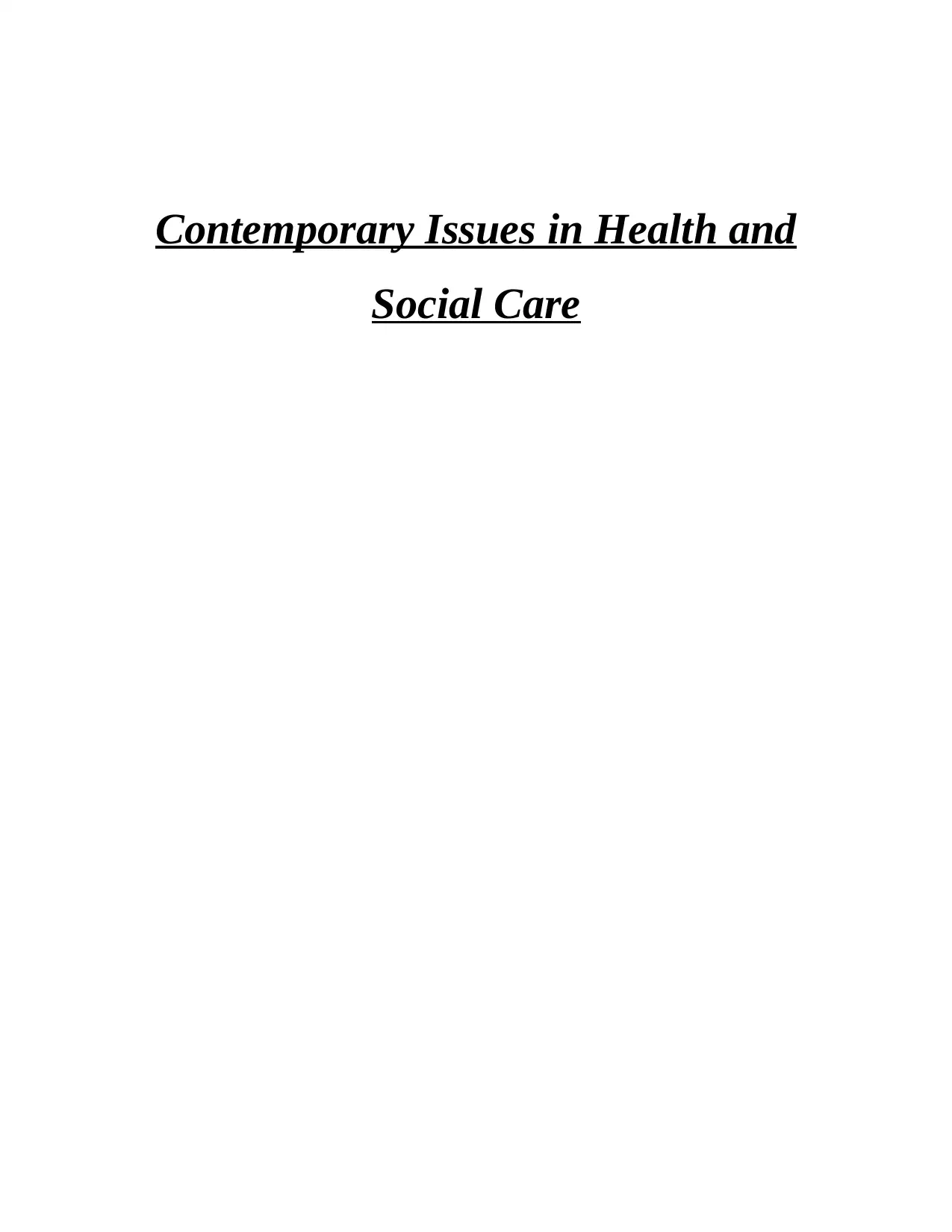
Contemporary Issues in Health and
Social Care
Social Care
Paraphrase This Document
Need a fresh take? Get an instant paraphrase of this document with our AI Paraphraser
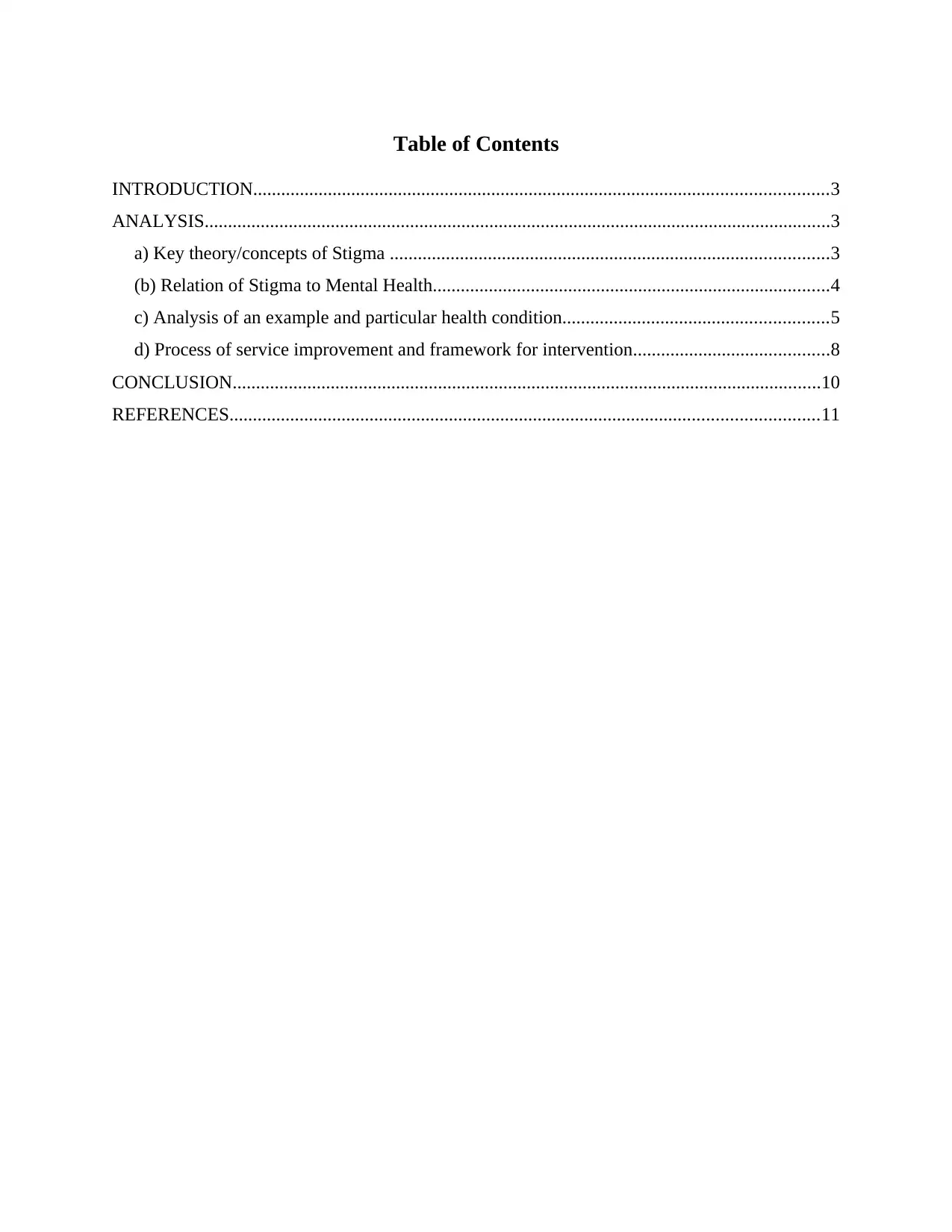
Table of Contents
INTRODUCTION...........................................................................................................................3
ANALYSIS......................................................................................................................................3
a) Key theory/concepts of Stigma ..............................................................................................3
(b) Relation of Stigma to Mental Health.....................................................................................4
c) Analysis of an example and particular health condition.........................................................5
d) Process of service improvement and framework for intervention..........................................8
CONCLUSION..............................................................................................................................10
REFERENCES..............................................................................................................................11
INTRODUCTION...........................................................................................................................3
ANALYSIS......................................................................................................................................3
a) Key theory/concepts of Stigma ..............................................................................................3
(b) Relation of Stigma to Mental Health.....................................................................................4
c) Analysis of an example and particular health condition.........................................................5
d) Process of service improvement and framework for intervention..........................................8
CONCLUSION..............................................................................................................................10
REFERENCES..............................................................................................................................11
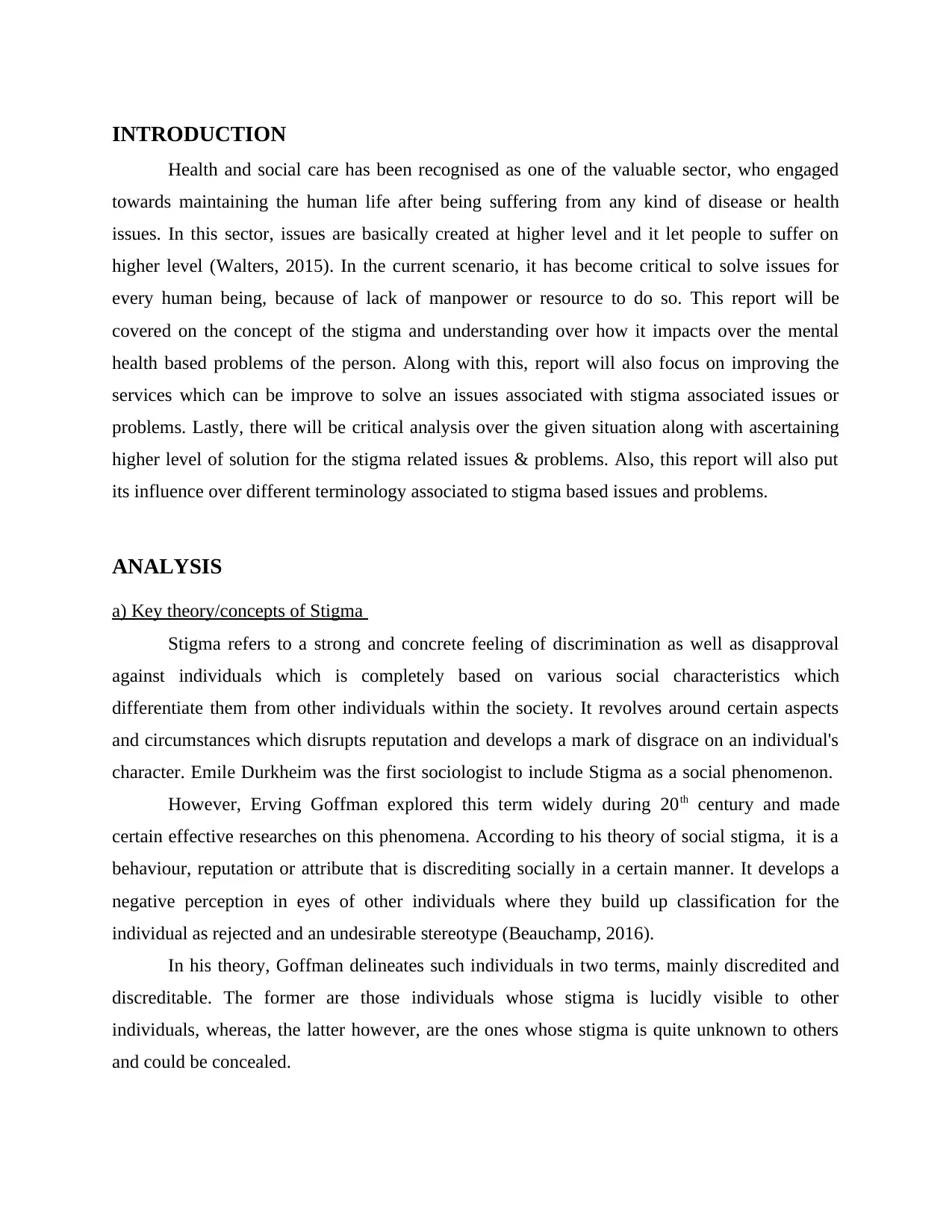
INTRODUCTION
Health and social care has been recognised as one of the valuable sector, who engaged
towards maintaining the human life after being suffering from any kind of disease or health
issues. In this sector, issues are basically created at higher level and it let people to suffer on
higher level (Walters, 2015). In the current scenario, it has become critical to solve issues for
every human being, because of lack of manpower or resource to do so. This report will be
covered on the concept of the stigma and understanding over how it impacts over the mental
health based problems of the person. Along with this, report will also focus on improving the
services which can be improve to solve an issues associated with stigma associated issues or
problems. Lastly, there will be critical analysis over the given situation along with ascertaining
higher level of solution for the stigma related issues & problems. Also, this report will also put
its influence over different terminology associated to stigma based issues and problems.
ANALYSIS
a) Key theory/concepts of Stigma
Stigma refers to a strong and concrete feeling of discrimination as well as disapproval
against individuals which is completely based on various social characteristics which
differentiate them from other individuals within the society. It revolves around certain aspects
and circumstances which disrupts reputation and develops a mark of disgrace on an individual's
character. Emile Durkheim was the first sociologist to include Stigma as a social phenomenon.
However, Erving Goffman explored this term widely during 20th century and made
certain effective researches on this phenomena. According to his theory of social stigma, it is a
behaviour, reputation or attribute that is discrediting socially in a certain manner. It develops a
negative perception in eyes of other individuals where they build up classification for the
individual as rejected and an undesirable stereotype (Beauchamp, 2016).
In his theory, Goffman delineates such individuals in two terms, mainly discredited and
discreditable. The former are those individuals whose stigma is lucidly visible to other
individuals, whereas, the latter however, are the ones whose stigma is quite unknown to others
and could be concealed.
Health and social care has been recognised as one of the valuable sector, who engaged
towards maintaining the human life after being suffering from any kind of disease or health
issues. In this sector, issues are basically created at higher level and it let people to suffer on
higher level (Walters, 2015). In the current scenario, it has become critical to solve issues for
every human being, because of lack of manpower or resource to do so. This report will be
covered on the concept of the stigma and understanding over how it impacts over the mental
health based problems of the person. Along with this, report will also focus on improving the
services which can be improve to solve an issues associated with stigma associated issues or
problems. Lastly, there will be critical analysis over the given situation along with ascertaining
higher level of solution for the stigma related issues & problems. Also, this report will also put
its influence over different terminology associated to stigma based issues and problems.
ANALYSIS
a) Key theory/concepts of Stigma
Stigma refers to a strong and concrete feeling of discrimination as well as disapproval
against individuals which is completely based on various social characteristics which
differentiate them from other individuals within the society. It revolves around certain aspects
and circumstances which disrupts reputation and develops a mark of disgrace on an individual's
character. Emile Durkheim was the first sociologist to include Stigma as a social phenomenon.
However, Erving Goffman explored this term widely during 20th century and made
certain effective researches on this phenomena. According to his theory of social stigma, it is a
behaviour, reputation or attribute that is discrediting socially in a certain manner. It develops a
negative perception in eyes of other individuals where they build up classification for the
individual as rejected and an undesirable stereotype (Beauchamp, 2016).
In his theory, Goffman delineates such individuals in two terms, mainly discredited and
discreditable. The former are those individuals whose stigma is lucidly visible to other
individuals, whereas, the latter however, are the ones whose stigma is quite unknown to others
and could be concealed.
⊘ This is a preview!⊘
Do you want full access?
Subscribe today to unlock all pages.

Trusted by 1+ million students worldwide
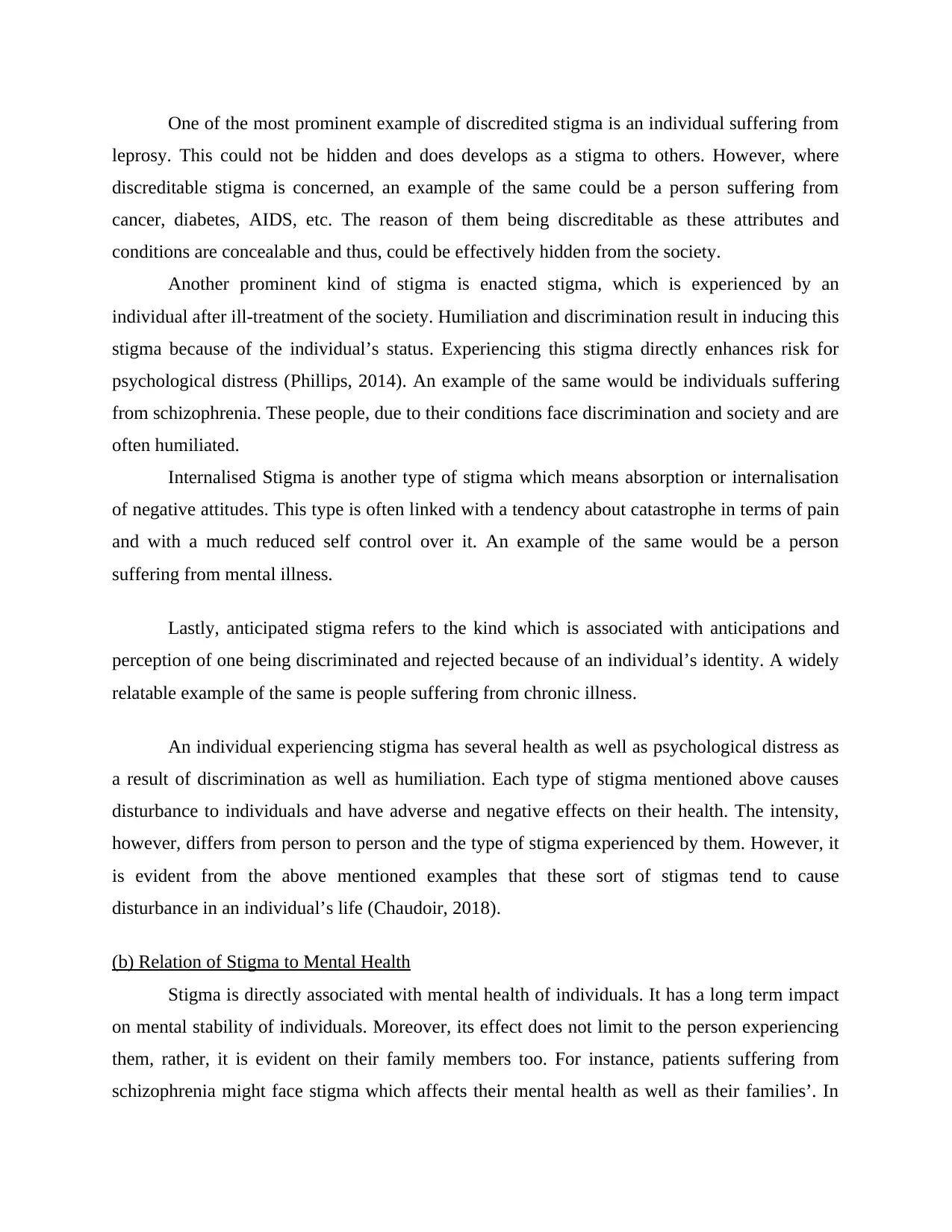
One of the most prominent example of discredited stigma is an individual suffering from
leprosy. This could not be hidden and does develops as a stigma to others. However, where
discreditable stigma is concerned, an example of the same could be a person suffering from
cancer, diabetes, AIDS, etc. The reason of them being discreditable as these attributes and
conditions are concealable and thus, could be effectively hidden from the society.
Another prominent kind of stigma is enacted stigma, which is experienced by an
individual after ill-treatment of the society. Humiliation and discrimination result in inducing this
stigma because of the individual’s status. Experiencing this stigma directly enhances risk for
psychological distress (Phillips, 2014). An example of the same would be individuals suffering
from schizophrenia. These people, due to their conditions face discrimination and society and are
often humiliated.
Internalised Stigma is another type of stigma which means absorption or internalisation
of negative attitudes. This type is often linked with a tendency about catastrophe in terms of pain
and with a much reduced self control over it. An example of the same would be a person
suffering from mental illness.
Lastly, anticipated stigma refers to the kind which is associated with anticipations and
perception of one being discriminated and rejected because of an individual’s identity. A widely
relatable example of the same is people suffering from chronic illness.
An individual experiencing stigma has several health as well as psychological distress as
a result of discrimination as well as humiliation. Each type of stigma mentioned above causes
disturbance to individuals and have adverse and negative effects on their health. The intensity,
however, differs from person to person and the type of stigma experienced by them. However, it
is evident from the above mentioned examples that these sort of stigmas tend to cause
disturbance in an individual’s life (Chaudoir, 2018).
(b) Relation of Stigma to Mental Health
Stigma is directly associated with mental health of individuals. It has a long term impact
on mental stability of individuals. Moreover, its effect does not limit to the person experiencing
them, rather, it is evident on their family members too. For instance, patients suffering from
schizophrenia might face stigma which affects their mental health as well as their families’. In
leprosy. This could not be hidden and does develops as a stigma to others. However, where
discreditable stigma is concerned, an example of the same could be a person suffering from
cancer, diabetes, AIDS, etc. The reason of them being discreditable as these attributes and
conditions are concealable and thus, could be effectively hidden from the society.
Another prominent kind of stigma is enacted stigma, which is experienced by an
individual after ill-treatment of the society. Humiliation and discrimination result in inducing this
stigma because of the individual’s status. Experiencing this stigma directly enhances risk for
psychological distress (Phillips, 2014). An example of the same would be individuals suffering
from schizophrenia. These people, due to their conditions face discrimination and society and are
often humiliated.
Internalised Stigma is another type of stigma which means absorption or internalisation
of negative attitudes. This type is often linked with a tendency about catastrophe in terms of pain
and with a much reduced self control over it. An example of the same would be a person
suffering from mental illness.
Lastly, anticipated stigma refers to the kind which is associated with anticipations and
perception of one being discriminated and rejected because of an individual’s identity. A widely
relatable example of the same is people suffering from chronic illness.
An individual experiencing stigma has several health as well as psychological distress as
a result of discrimination as well as humiliation. Each type of stigma mentioned above causes
disturbance to individuals and have adverse and negative effects on their health. The intensity,
however, differs from person to person and the type of stigma experienced by them. However, it
is evident from the above mentioned examples that these sort of stigmas tend to cause
disturbance in an individual’s life (Chaudoir, 2018).
(b) Relation of Stigma to Mental Health
Stigma is directly associated with mental health of individuals. It has a long term impact
on mental stability of individuals. Moreover, its effect does not limit to the person experiencing
them, rather, it is evident on their family members too. For instance, patients suffering from
schizophrenia might face stigma which affects their mental health as well as their families’. In
Paraphrase This Document
Need a fresh take? Get an instant paraphrase of this document with our AI Paraphraser
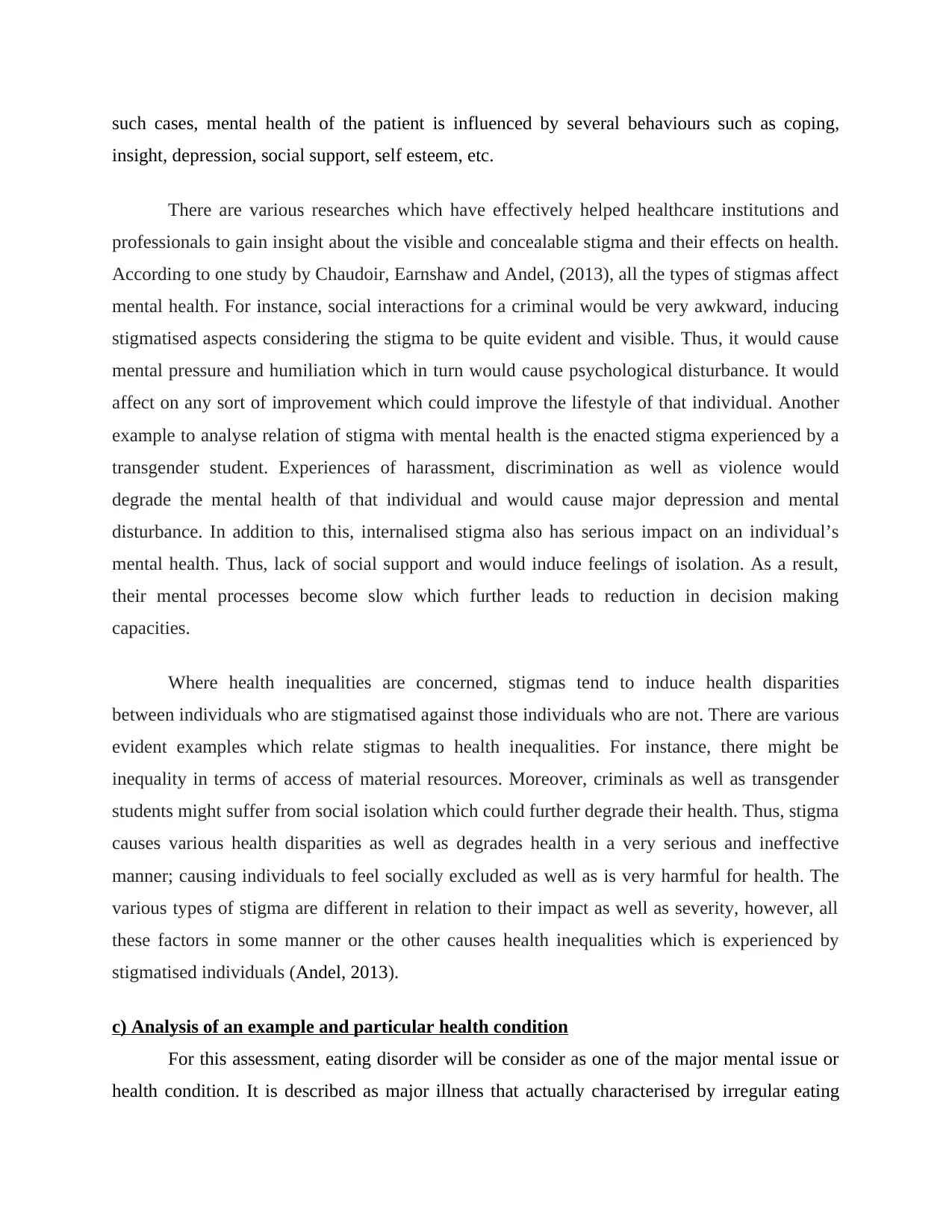
such cases, mental health of the patient is influenced by several behaviours such as coping,
insight, depression, social support, self esteem, etc.
There are various researches which have effectively helped healthcare institutions and
professionals to gain insight about the visible and concealable stigma and their effects on health.
According to one study by Chaudoir, Earnshaw and Andel, (2013), all the types of stigmas affect
mental health. For instance, social interactions for a criminal would be very awkward, inducing
stigmatised aspects considering the stigma to be quite evident and visible. Thus, it would cause
mental pressure and humiliation which in turn would cause psychological disturbance. It would
affect on any sort of improvement which could improve the lifestyle of that individual. Another
example to analyse relation of stigma with mental health is the enacted stigma experienced by a
transgender student. Experiences of harassment, discrimination as well as violence would
degrade the mental health of that individual and would cause major depression and mental
disturbance. In addition to this, internalised stigma also has serious impact on an individual’s
mental health. Thus, lack of social support and would induce feelings of isolation. As a result,
their mental processes become slow which further leads to reduction in decision making
capacities.
Where health inequalities are concerned, stigmas tend to induce health disparities
between individuals who are stigmatised against those individuals who are not. There are various
evident examples which relate stigmas to health inequalities. For instance, there might be
inequality in terms of access of material resources. Moreover, criminals as well as transgender
students might suffer from social isolation which could further degrade their health. Thus, stigma
causes various health disparities as well as degrades health in a very serious and ineffective
manner; causing individuals to feel socially excluded as well as is very harmful for health. The
various types of stigma are different in relation to their impact as well as severity, however, all
these factors in some manner or the other causes health inequalities which is experienced by
stigmatised individuals (Andel, 2013).
c) Analysis of an example and particular health condition
For this assessment, eating disorder will be consider as one of the major mental issue or
health condition. It is described as major illness that actually characterised by irregular eating
insight, depression, social support, self esteem, etc.
There are various researches which have effectively helped healthcare institutions and
professionals to gain insight about the visible and concealable stigma and their effects on health.
According to one study by Chaudoir, Earnshaw and Andel, (2013), all the types of stigmas affect
mental health. For instance, social interactions for a criminal would be very awkward, inducing
stigmatised aspects considering the stigma to be quite evident and visible. Thus, it would cause
mental pressure and humiliation which in turn would cause psychological disturbance. It would
affect on any sort of improvement which could improve the lifestyle of that individual. Another
example to analyse relation of stigma with mental health is the enacted stigma experienced by a
transgender student. Experiences of harassment, discrimination as well as violence would
degrade the mental health of that individual and would cause major depression and mental
disturbance. In addition to this, internalised stigma also has serious impact on an individual’s
mental health. Thus, lack of social support and would induce feelings of isolation. As a result,
their mental processes become slow which further leads to reduction in decision making
capacities.
Where health inequalities are concerned, stigmas tend to induce health disparities
between individuals who are stigmatised against those individuals who are not. There are various
evident examples which relate stigmas to health inequalities. For instance, there might be
inequality in terms of access of material resources. Moreover, criminals as well as transgender
students might suffer from social isolation which could further degrade their health. Thus, stigma
causes various health disparities as well as degrades health in a very serious and ineffective
manner; causing individuals to feel socially excluded as well as is very harmful for health. The
various types of stigma are different in relation to their impact as well as severity, however, all
these factors in some manner or the other causes health inequalities which is experienced by
stigmatised individuals (Andel, 2013).
c) Analysis of an example and particular health condition
For this assessment, eating disorder will be consider as one of the major mental issue or
health condition. It is described as major illness that actually characterised by irregular eating
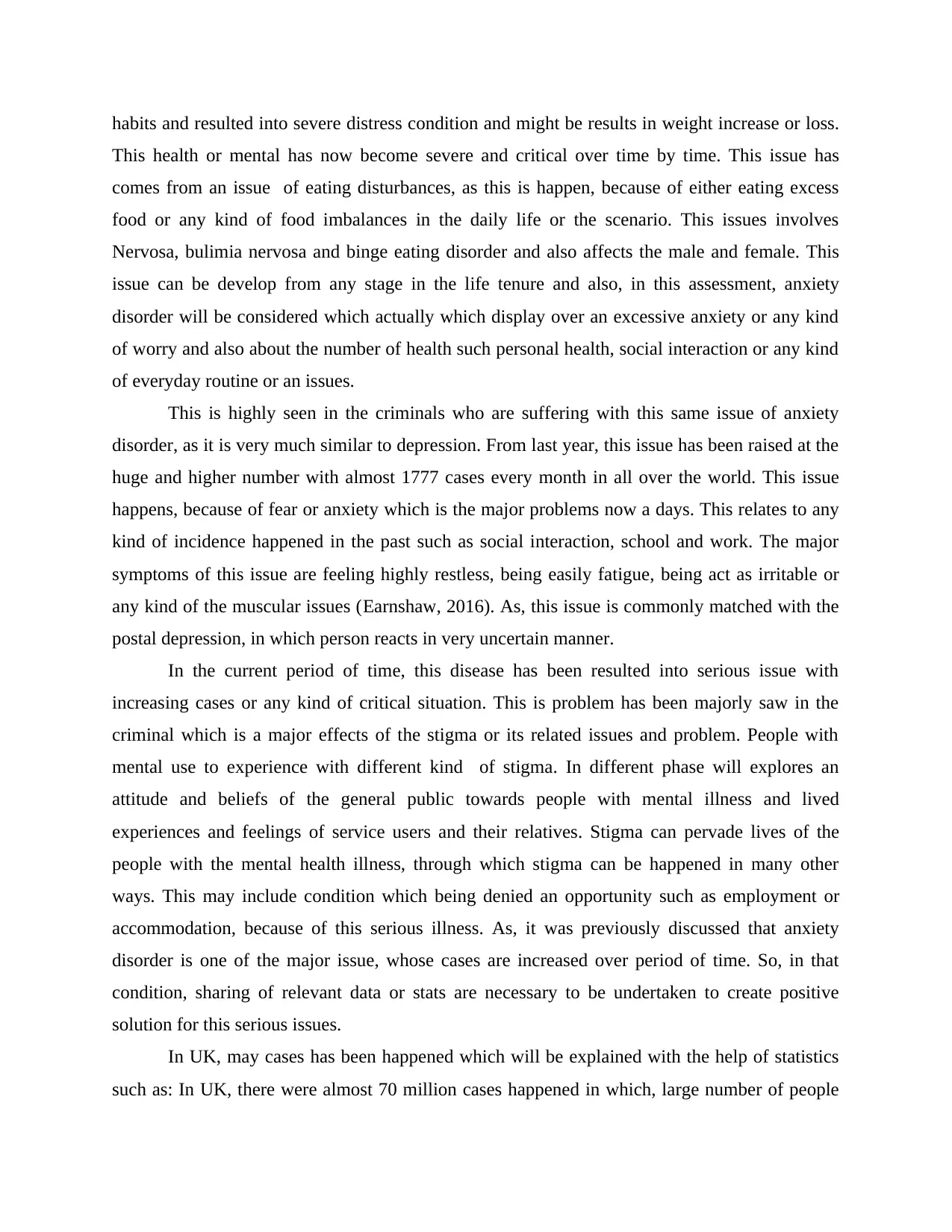
habits and resulted into severe distress condition and might be results in weight increase or loss.
This health or mental has now become severe and critical over time by time. This issue has
comes from an issue of eating disturbances, as this is happen, because of either eating excess
food or any kind of food imbalances in the daily life or the scenario. This issues involves
Nervosa, bulimia nervosa and binge eating disorder and also affects the male and female. This
issue can be develop from any stage in the life tenure and also, in this assessment, anxiety
disorder will be considered which actually which display over an excessive anxiety or any kind
of worry and also about the number of health such personal health, social interaction or any kind
of everyday routine or an issues.
This is highly seen in the criminals who are suffering with this same issue of anxiety
disorder, as it is very much similar to depression. From last year, this issue has been raised at the
huge and higher number with almost 1777 cases every month in all over the world. This issue
happens, because of fear or anxiety which is the major problems now a days. This relates to any
kind of incidence happened in the past such as social interaction, school and work. The major
symptoms of this issue are feeling highly restless, being easily fatigue, being act as irritable or
any kind of the muscular issues (Earnshaw, 2016). As, this issue is commonly matched with the
postal depression, in which person reacts in very uncertain manner.
In the current period of time, this disease has been resulted into serious issue with
increasing cases or any kind of critical situation. This is problem has been majorly saw in the
criminal which is a major effects of the stigma or its related issues and problem. People with
mental use to experience with different kind of stigma. In different phase will explores an
attitude and beliefs of the general public towards people with mental illness and lived
experiences and feelings of service users and their relatives. Stigma can pervade lives of the
people with the mental health illness, through which stigma can be happened in many other
ways. This may include condition which being denied an opportunity such as employment or
accommodation, because of this serious illness. As, it was previously discussed that anxiety
disorder is one of the major issue, whose cases are increased over period of time. So, in that
condition, sharing of relevant data or stats are necessary to be undertaken to create positive
solution for this serious issues.
In UK, may cases has been happened which will be explained with the help of statistics
such as: In UK, there were almost 70 million cases happened in which, large number of people
This health or mental has now become severe and critical over time by time. This issue has
comes from an issue of eating disturbances, as this is happen, because of either eating excess
food or any kind of food imbalances in the daily life or the scenario. This issues involves
Nervosa, bulimia nervosa and binge eating disorder and also affects the male and female. This
issue can be develop from any stage in the life tenure and also, in this assessment, anxiety
disorder will be considered which actually which display over an excessive anxiety or any kind
of worry and also about the number of health such personal health, social interaction or any kind
of everyday routine or an issues.
This is highly seen in the criminals who are suffering with this same issue of anxiety
disorder, as it is very much similar to depression. From last year, this issue has been raised at the
huge and higher number with almost 1777 cases every month in all over the world. This issue
happens, because of fear or anxiety which is the major problems now a days. This relates to any
kind of incidence happened in the past such as social interaction, school and work. The major
symptoms of this issue are feeling highly restless, being easily fatigue, being act as irritable or
any kind of the muscular issues (Earnshaw, 2016). As, this issue is commonly matched with the
postal depression, in which person reacts in very uncertain manner.
In the current period of time, this disease has been resulted into serious issue with
increasing cases or any kind of critical situation. This is problem has been majorly saw in the
criminal which is a major effects of the stigma or its related issues and problem. People with
mental use to experience with different kind of stigma. In different phase will explores an
attitude and beliefs of the general public towards people with mental illness and lived
experiences and feelings of service users and their relatives. Stigma can pervade lives of the
people with the mental health illness, through which stigma can be happened in many other
ways. This may include condition which being denied an opportunity such as employment or
accommodation, because of this serious illness. As, it was previously discussed that anxiety
disorder is one of the major issue, whose cases are increased over period of time. So, in that
condition, sharing of relevant data or stats are necessary to be undertaken to create positive
solution for this serious issues.
In UK, may cases has been happened which will be explained with the help of statistics
such as: In UK, there were almost 70 million cases happened in which, large number of people
⊘ This is a preview!⊘
Do you want full access?
Subscribe today to unlock all pages.

Trusted by 1+ million students worldwide
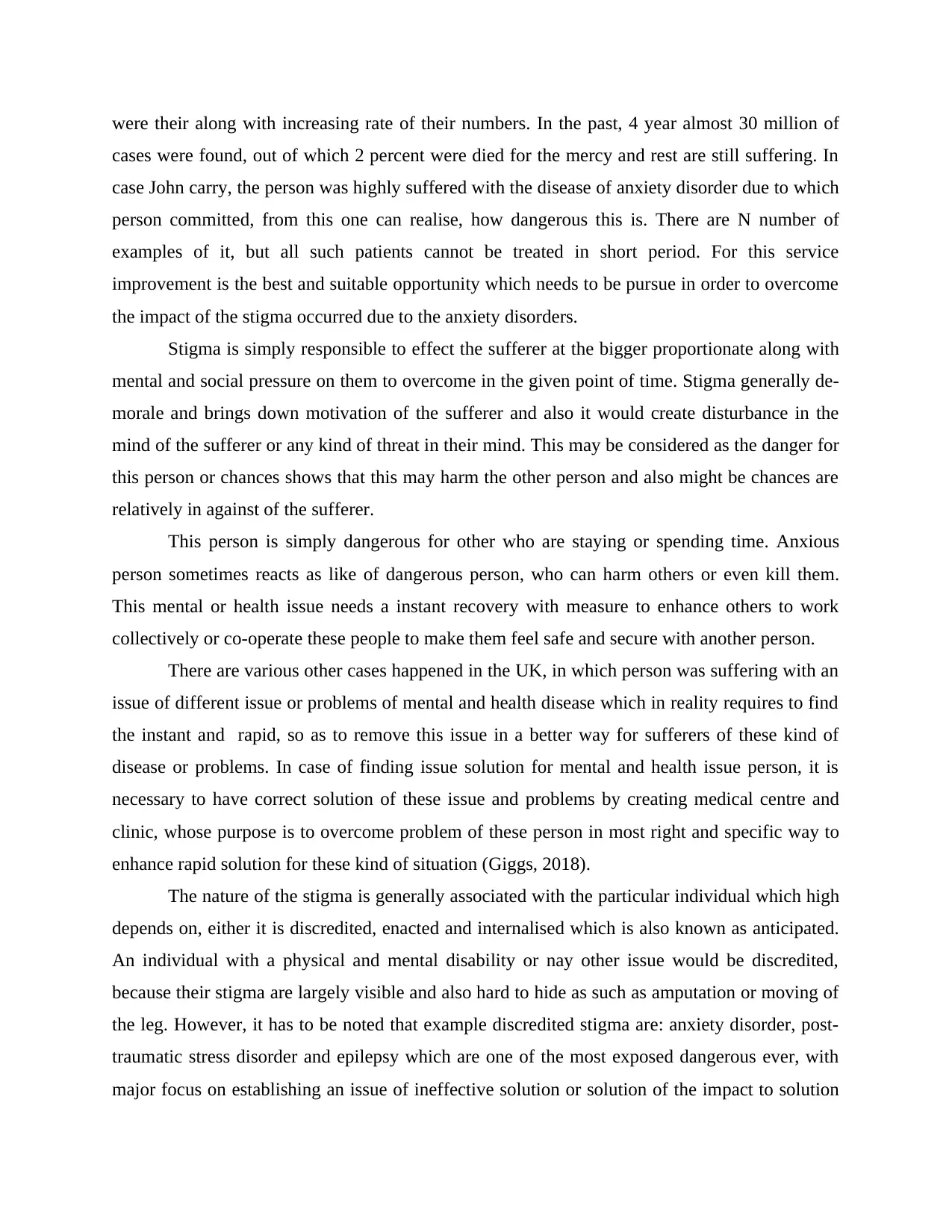
were their along with increasing rate of their numbers. In the past, 4 year almost 30 million of
cases were found, out of which 2 percent were died for the mercy and rest are still suffering. In
case John carry, the person was highly suffered with the disease of anxiety disorder due to which
person committed, from this one can realise, how dangerous this is. There are N number of
examples of it, but all such patients cannot be treated in short period. For this service
improvement is the best and suitable opportunity which needs to be pursue in order to overcome
the impact of the stigma occurred due to the anxiety disorders.
Stigma is simply responsible to effect the sufferer at the bigger proportionate along with
mental and social pressure on them to overcome in the given point of time. Stigma generally de-
morale and brings down motivation of the sufferer and also it would create disturbance in the
mind of the sufferer or any kind of threat in their mind. This may be considered as the danger for
this person or chances shows that this may harm the other person and also might be chances are
relatively in against of the sufferer.
This person is simply dangerous for other who are staying or spending time. Anxious
person sometimes reacts as like of dangerous person, who can harm others or even kill them.
This mental or health issue needs a instant recovery with measure to enhance others to work
collectively or co-operate these people to make them feel safe and secure with another person.
There are various other cases happened in the UK, in which person was suffering with an
issue of different issue or problems of mental and health disease which in reality requires to find
the instant and rapid, so as to remove this issue in a better way for sufferers of these kind of
disease or problems. In case of finding issue solution for mental and health issue person, it is
necessary to have correct solution of these issue and problems by creating medical centre and
clinic, whose purpose is to overcome problem of these person in most right and specific way to
enhance rapid solution for these kind of situation (Giggs, 2018).
The nature of the stigma is generally associated with the particular individual which high
depends on, either it is discredited, enacted and internalised which is also known as anticipated.
An individual with a physical and mental disability or nay other issue would be discredited,
because their stigma are largely visible and also hard to hide as such as amputation or moving of
the leg. However, it has to be noted that example discredited stigma are: anxiety disorder, post-
traumatic stress disorder and epilepsy which are one of the most exposed dangerous ever, with
major focus on establishing an issue of ineffective solution or solution of the impact to solution
cases were found, out of which 2 percent were died for the mercy and rest are still suffering. In
case John carry, the person was highly suffered with the disease of anxiety disorder due to which
person committed, from this one can realise, how dangerous this is. There are N number of
examples of it, but all such patients cannot be treated in short period. For this service
improvement is the best and suitable opportunity which needs to be pursue in order to overcome
the impact of the stigma occurred due to the anxiety disorders.
Stigma is simply responsible to effect the sufferer at the bigger proportionate along with
mental and social pressure on them to overcome in the given point of time. Stigma generally de-
morale and brings down motivation of the sufferer and also it would create disturbance in the
mind of the sufferer or any kind of threat in their mind. This may be considered as the danger for
this person or chances shows that this may harm the other person and also might be chances are
relatively in against of the sufferer.
This person is simply dangerous for other who are staying or spending time. Anxious
person sometimes reacts as like of dangerous person, who can harm others or even kill them.
This mental or health issue needs a instant recovery with measure to enhance others to work
collectively or co-operate these people to make them feel safe and secure with another person.
There are various other cases happened in the UK, in which person was suffering with an
issue of different issue or problems of mental and health disease which in reality requires to find
the instant and rapid, so as to remove this issue in a better way for sufferers of these kind of
disease or problems. In case of finding issue solution for mental and health issue person, it is
necessary to have correct solution of these issue and problems by creating medical centre and
clinic, whose purpose is to overcome problem of these person in most right and specific way to
enhance rapid solution for these kind of situation (Giggs, 2018).
The nature of the stigma is generally associated with the particular individual which high
depends on, either it is discredited, enacted and internalised which is also known as anticipated.
An individual with a physical and mental disability or nay other issue would be discredited,
because their stigma are largely visible and also hard to hide as such as amputation or moving of
the leg. However, it has to be noted that example discredited stigma are: anxiety disorder, post-
traumatic stress disorder and epilepsy which are one of the most exposed dangerous ever, with
major focus on establishing an issue of ineffective solution or solution of the impact to solution
Paraphrase This Document
Need a fresh take? Get an instant paraphrase of this document with our AI Paraphraser
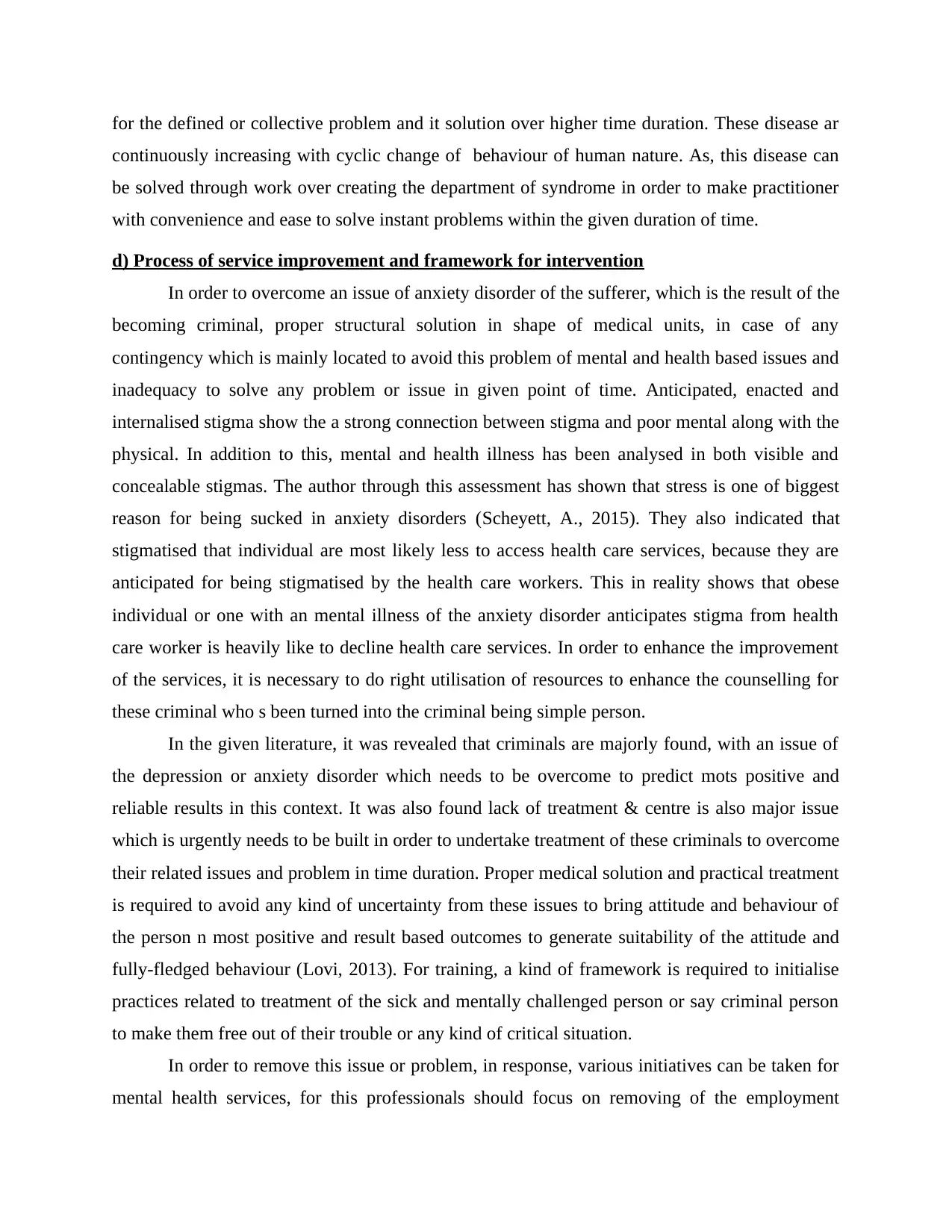
for the defined or collective problem and it solution over higher time duration. These disease ar
continuously increasing with cyclic change of behaviour of human nature. As, this disease can
be solved through work over creating the department of syndrome in order to make practitioner
with convenience and ease to solve instant problems within the given duration of time.
d) Process of service improvement and framework for intervention
In order to overcome an issue of anxiety disorder of the sufferer, which is the result of the
becoming criminal, proper structural solution in shape of medical units, in case of any
contingency which is mainly located to avoid this problem of mental and health based issues and
inadequacy to solve any problem or issue in given point of time. Anticipated, enacted and
internalised stigma show the a strong connection between stigma and poor mental along with the
physical. In addition to this, mental and health illness has been analysed in both visible and
concealable stigmas. The author through this assessment has shown that stress is one of biggest
reason for being sucked in anxiety disorders (Scheyett, A., 2015). They also indicated that
stigmatised that individual are most likely less to access health care services, because they are
anticipated for being stigmatised by the health care workers. This in reality shows that obese
individual or one with an mental illness of the anxiety disorder anticipates stigma from health
care worker is heavily like to decline health care services. In order to enhance the improvement
of the services, it is necessary to do right utilisation of resources to enhance the counselling for
these criminal who s been turned into the criminal being simple person.
In the given literature, it was revealed that criminals are majorly found, with an issue of
the depression or anxiety disorder which needs to be overcome to predict mots positive and
reliable results in this context. It was also found lack of treatment & centre is also major issue
which is urgently needs to be built in order to undertake treatment of these criminals to overcome
their related issues and problem in time duration. Proper medical solution and practical treatment
is required to avoid any kind of uncertainty from these issues to bring attitude and behaviour of
the person n most positive and result based outcomes to generate suitability of the attitude and
fully-fledged behaviour (Lovi, 2013). For training, a kind of framework is required to initialise
practices related to treatment of the sick and mentally challenged person or say criminal person
to make them free out of their trouble or any kind of critical situation.
In order to remove this issue or problem, in response, various initiatives can be taken for
mental health services, for this professionals should focus on removing of the employment
continuously increasing with cyclic change of behaviour of human nature. As, this disease can
be solved through work over creating the department of syndrome in order to make practitioner
with convenience and ease to solve instant problems within the given duration of time.
d) Process of service improvement and framework for intervention
In order to overcome an issue of anxiety disorder of the sufferer, which is the result of the
becoming criminal, proper structural solution in shape of medical units, in case of any
contingency which is mainly located to avoid this problem of mental and health based issues and
inadequacy to solve any problem or issue in given point of time. Anticipated, enacted and
internalised stigma show the a strong connection between stigma and poor mental along with the
physical. In addition to this, mental and health illness has been analysed in both visible and
concealable stigmas. The author through this assessment has shown that stress is one of biggest
reason for being sucked in anxiety disorders (Scheyett, A., 2015). They also indicated that
stigmatised that individual are most likely less to access health care services, because they are
anticipated for being stigmatised by the health care workers. This in reality shows that obese
individual or one with an mental illness of the anxiety disorder anticipates stigma from health
care worker is heavily like to decline health care services. In order to enhance the improvement
of the services, it is necessary to do right utilisation of resources to enhance the counselling for
these criminal who s been turned into the criminal being simple person.
In the given literature, it was revealed that criminals are majorly found, with an issue of
the depression or anxiety disorder which needs to be overcome to predict mots positive and
reliable results in this context. It was also found lack of treatment & centre is also major issue
which is urgently needs to be built in order to undertake treatment of these criminals to overcome
their related issues and problem in time duration. Proper medical solution and practical treatment
is required to avoid any kind of uncertainty from these issues to bring attitude and behaviour of
the person n most positive and result based outcomes to generate suitability of the attitude and
fully-fledged behaviour (Lovi, 2013). For training, a kind of framework is required to initialise
practices related to treatment of the sick and mentally challenged person or say criminal person
to make them free out of their trouble or any kind of critical situation.
In order to remove this issue or problem, in response, various initiatives can be taken for
mental health services, for this professionals should focus on removing of the employment
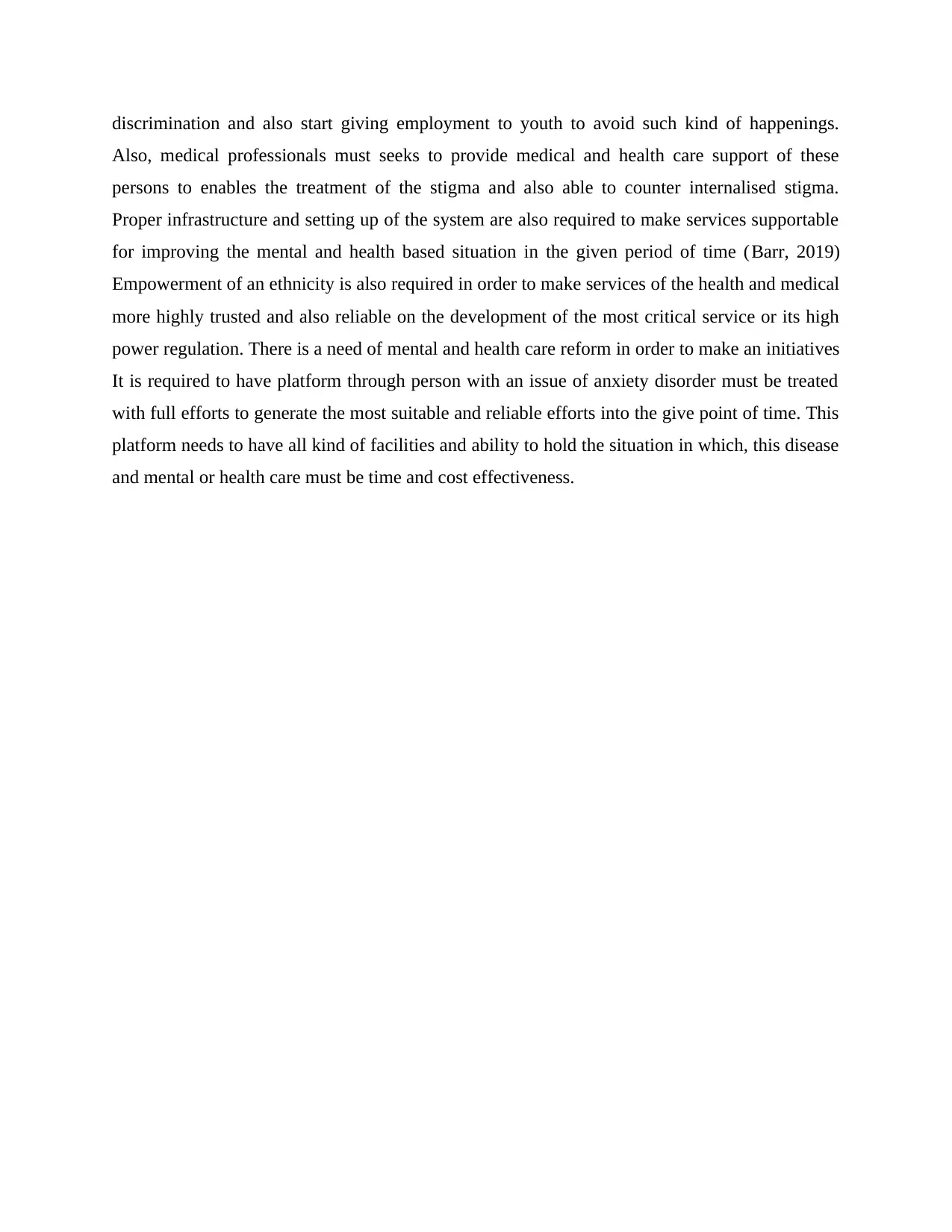
discrimination and also start giving employment to youth to avoid such kind of happenings.
Also, medical professionals must seeks to provide medical and health care support of these
persons to enables the treatment of the stigma and also able to counter internalised stigma.
Proper infrastructure and setting up of the system are also required to make services supportable
for improving the mental and health based situation in the given period of time (Barr, 2019)
Empowerment of an ethnicity is also required in order to make services of the health and medical
more highly trusted and also reliable on the development of the most critical service or its high
power regulation. There is a need of mental and health care reform in order to make an initiatives
It is required to have platform through person with an issue of anxiety disorder must be treated
with full efforts to generate the most suitable and reliable efforts into the give point of time. This
platform needs to have all kind of facilities and ability to hold the situation in which, this disease
and mental or health care must be time and cost effectiveness.
Also, medical professionals must seeks to provide medical and health care support of these
persons to enables the treatment of the stigma and also able to counter internalised stigma.
Proper infrastructure and setting up of the system are also required to make services supportable
for improving the mental and health based situation in the given period of time (Barr, 2019)
Empowerment of an ethnicity is also required in order to make services of the health and medical
more highly trusted and also reliable on the development of the most critical service or its high
power regulation. There is a need of mental and health care reform in order to make an initiatives
It is required to have platform through person with an issue of anxiety disorder must be treated
with full efforts to generate the most suitable and reliable efforts into the give point of time. This
platform needs to have all kind of facilities and ability to hold the situation in which, this disease
and mental or health care must be time and cost effectiveness.
⊘ This is a preview!⊘
Do you want full access?
Subscribe today to unlock all pages.

Trusted by 1+ million students worldwide
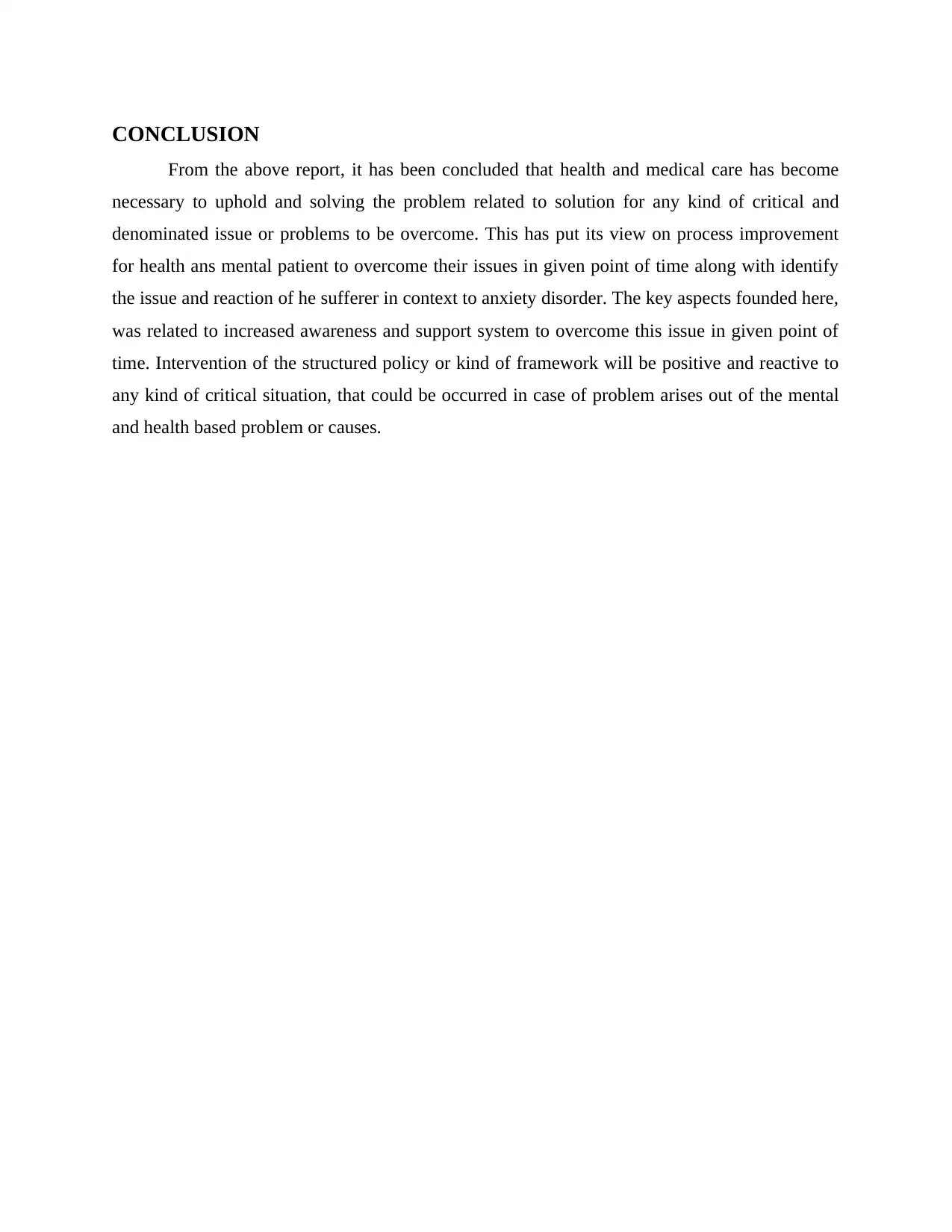
CONCLUSION
From the above report, it has been concluded that health and medical care has become
necessary to uphold and solving the problem related to solution for any kind of critical and
denominated issue or problems to be overcome. This has put its view on process improvement
for health ans mental patient to overcome their issues in given point of time along with identify
the issue and reaction of he sufferer in context to anxiety disorder. The key aspects founded here,
was related to increased awareness and support system to overcome this issue in given point of
time. Intervention of the structured policy or kind of framework will be positive and reactive to
any kind of critical situation, that could be occurred in case of problem arises out of the mental
and health based problem or causes.
From the above report, it has been concluded that health and medical care has become
necessary to uphold and solving the problem related to solution for any kind of critical and
denominated issue or problems to be overcome. This has put its view on process improvement
for health ans mental patient to overcome their issues in given point of time along with identify
the issue and reaction of he sufferer in context to anxiety disorder. The key aspects founded here,
was related to increased awareness and support system to overcome this issue in given point of
time. Intervention of the structured policy or kind of framework will be positive and reactive to
any kind of critical situation, that could be occurred in case of problem arises out of the mental
and health based problem or causes.
Paraphrase This Document
Need a fresh take? Get an instant paraphrase of this document with our AI Paraphraser
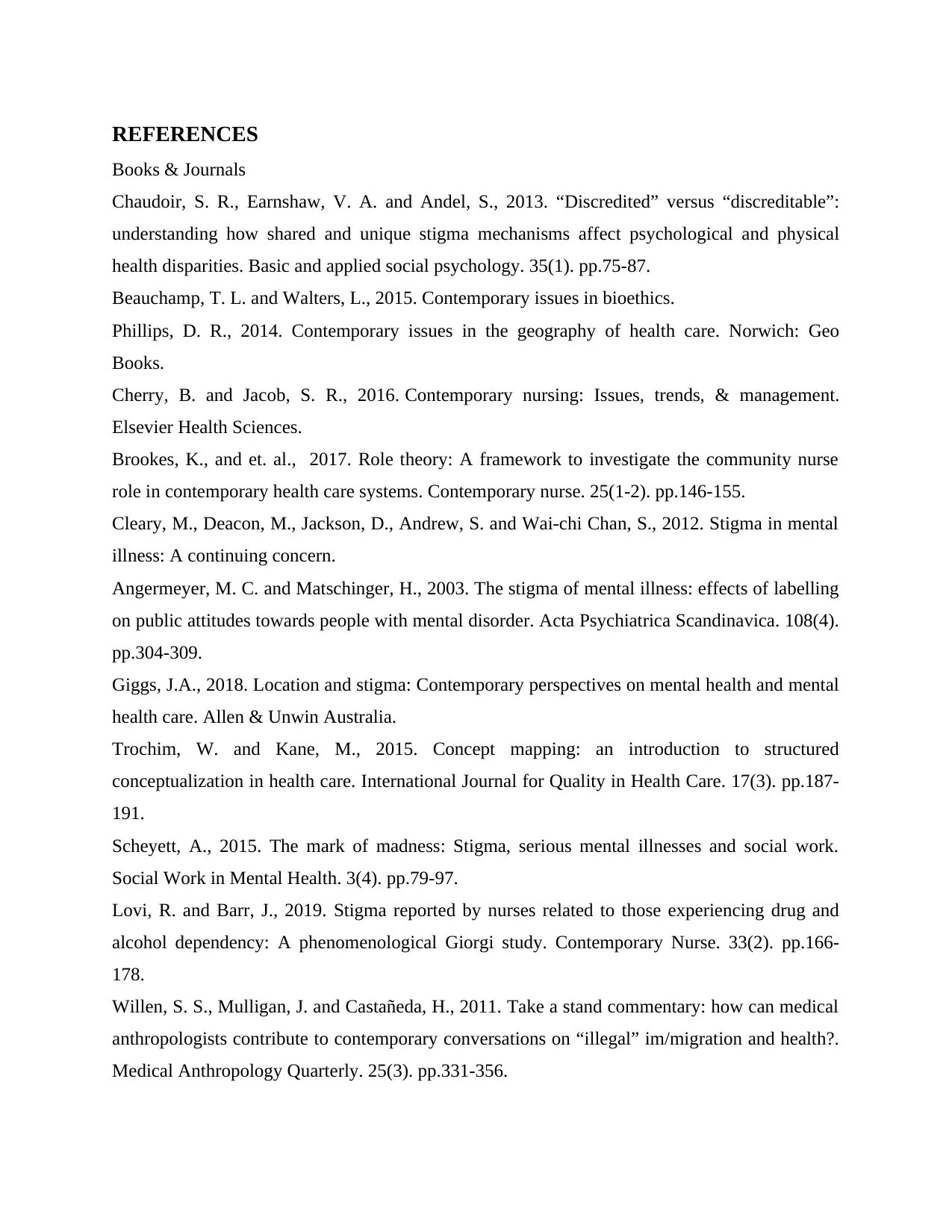
REFERENCES
Books & Journals
Chaudoir, S. R., Earnshaw, V. A. and Andel, S., 2013. “Discredited” versus “discreditable”:
understanding how shared and unique stigma mechanisms affect psychological and physical
health disparities. Basic and applied social psychology. 35(1). pp.75-87.
Beauchamp, T. L. and Walters, L., 2015. Contemporary issues in bioethics.
Phillips, D. R., 2014. Contemporary issues in the geography of health care. Norwich: Geo
Books.
Cherry, B. and Jacob, S. R., 2016. Contemporary nursing: Issues, trends, & management.
Elsevier Health Sciences.
Brookes, K., and et. al., 2017. Role theory: A framework to investigate the community nurse
role in contemporary health care systems. Contemporary nurse. 25(1-2). pp.146-155.
Cleary, M., Deacon, M., Jackson, D., Andrew, S. and Wai-chi Chan, S., 2012. Stigma in mental
illness: A continuing concern.
Angermeyer, M. C. and Matschinger, H., 2003. The stigma of mental illness: effects of labelling
on public attitudes towards people with mental disorder. Acta Psychiatrica Scandinavica. 108(4).
pp.304-309.
Giggs, J.A., 2018. Location and stigma: Contemporary perspectives on mental health and mental
health care. Allen & Unwin Australia.
Trochim, W. and Kane, M., 2015. Concept mapping: an introduction to structured
conceptualization in health care. International Journal for Quality in Health Care. 17(3). pp.187-
191.
Scheyett, A., 2015. The mark of madness: Stigma, serious mental illnesses and social work.
Social Work in Mental Health. 3(4). pp.79-97.
Lovi, R. and Barr, J., 2019. Stigma reported by nurses related to those experiencing drug and
alcohol dependency: A phenomenological Giorgi study. Contemporary Nurse. 33(2). pp.166-
178.
Willen, S. S., Mulligan, J. and Castañeda, H., 2011. Take a stand commentary: how can medical
anthropologists contribute to contemporary conversations on “illegal” im/migration and health?.
Medical Anthropology Quarterly. 25(3). pp.331-356.
Books & Journals
Chaudoir, S. R., Earnshaw, V. A. and Andel, S., 2013. “Discredited” versus “discreditable”:
understanding how shared and unique stigma mechanisms affect psychological and physical
health disparities. Basic and applied social psychology. 35(1). pp.75-87.
Beauchamp, T. L. and Walters, L., 2015. Contemporary issues in bioethics.
Phillips, D. R., 2014. Contemporary issues in the geography of health care. Norwich: Geo
Books.
Cherry, B. and Jacob, S. R., 2016. Contemporary nursing: Issues, trends, & management.
Elsevier Health Sciences.
Brookes, K., and et. al., 2017. Role theory: A framework to investigate the community nurse
role in contemporary health care systems. Contemporary nurse. 25(1-2). pp.146-155.
Cleary, M., Deacon, M., Jackson, D., Andrew, S. and Wai-chi Chan, S., 2012. Stigma in mental
illness: A continuing concern.
Angermeyer, M. C. and Matschinger, H., 2003. The stigma of mental illness: effects of labelling
on public attitudes towards people with mental disorder. Acta Psychiatrica Scandinavica. 108(4).
pp.304-309.
Giggs, J.A., 2018. Location and stigma: Contemporary perspectives on mental health and mental
health care. Allen & Unwin Australia.
Trochim, W. and Kane, M., 2015. Concept mapping: an introduction to structured
conceptualization in health care. International Journal for Quality in Health Care. 17(3). pp.187-
191.
Scheyett, A., 2015. The mark of madness: Stigma, serious mental illnesses and social work.
Social Work in Mental Health. 3(4). pp.79-97.
Lovi, R. and Barr, J., 2019. Stigma reported by nurses related to those experiencing drug and
alcohol dependency: A phenomenological Giorgi study. Contemporary Nurse. 33(2). pp.166-
178.
Willen, S. S., Mulligan, J. and Castañeda, H., 2011. Take a stand commentary: how can medical
anthropologists contribute to contemporary conversations on “illegal” im/migration and health?.
Medical Anthropology Quarterly. 25(3). pp.331-356.
1 out of 11
Related Documents
Your All-in-One AI-Powered Toolkit for Academic Success.
+13062052269
info@desklib.com
Available 24*7 on WhatsApp / Email
![[object Object]](/_next/static/media/star-bottom.7253800d.svg)
Unlock your academic potential
Copyright © 2020–2025 A2Z Services. All Rights Reserved. Developed and managed by ZUCOL.





